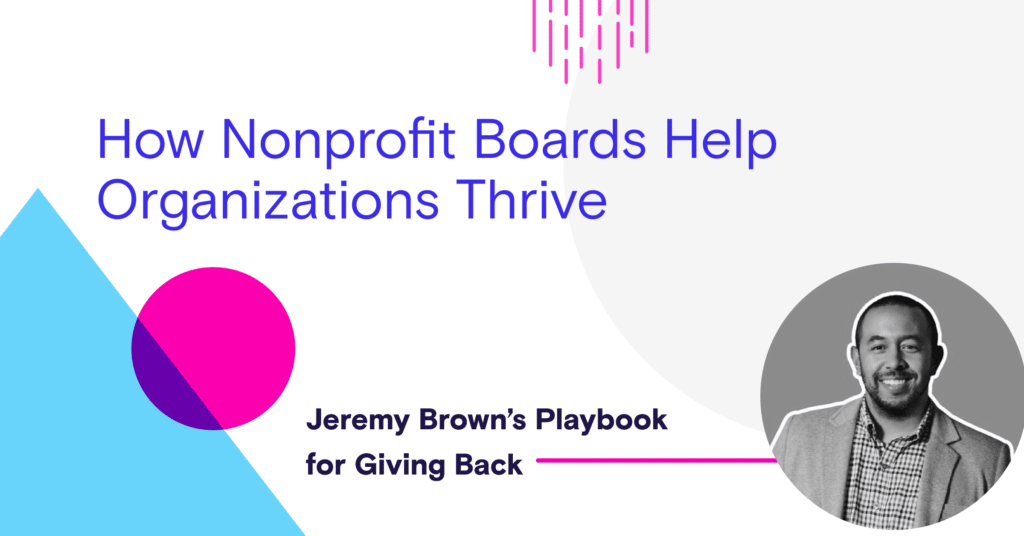
Jeremy Brown believes in more than just profit. He wants to make an impact. He shares how to make giving back part of your organization's DNA.
Jeremy Brown’s personal mission is simple: He wants more companies to care about impact, not just profit.
He knows firsthand that it’s possible. He’s worked for huge companies where giving back wasn’t a priority, and tiny ones that had philanthropy built into their DNA.
Once Jeremy realized how easy and rewarding corporate volunteering was for companies of any size, he started to spread the give-back gospel by founding Startups Give Back and Social Impact World.
It seemed almost fated that he would join a nonprofit board at some point, and the opportunity arose when he formed a connection with Shell Cleave of Sea Hugger, a participant in his 2017 Changemaker Forum.
Sea Hugger, whose mission is to protect and heal the ocean from plastic pollution through education and action, marked Jeremy’s first time serving on a board of directors. At first, the nuances of the role surprised him. Yet he soon applied the best practices he learned from both the business world and the social impact world to chart a new understanding of the purpose of nonprofit boards—and how they can help nonprofit organizations scale and thrive.
Here Jeremy breaks down:
- The true purpose of nonprofit boards
- The 4 key players every nonprofit board needs
- The 4 steps to keep funding flowing
The True Purpose of Nonprofit Boards
Nonprofit boards don’t run organizations. They power them.
Now, two years into his role as a board member with Sea Hugger, Jeremy’s understanding of how nonprofit boards work and the role board members play is entirely different than when he started.
“Prior to being on the board, my perspective was that the board of directors were always the bosses of the founders and the executives,” Jeremy says. “But really, a board of directors is a team that’s meant to help you [the founder] in areas you’re not proficient at.”
This insight is particularly true of nonprofit organizations versus for-profit companies.
For instance, if you’re a for-profit company and you have gaps in your expertise that you need to fill, you make a new hire. If you’re a nonprofit organization and you have an expertise gap, you find a new board member.
“A nonprofit may not have the resources to be able to hire people,”Jeremy says. “When you are building a board of directors, it’s really important to find people that bring expertise you may not have that can help you scale the organization.”
Jeremy’s expansive network and skill in relationship- building is part of the value he brings to Sea Hugger. As a board member, he’s able to bring in new connections whothat care about the Sea Hugger mission and can get involved as a donor, volunteer, or even join the executive team or become a future board member.
If you’re interested in joining forces with a nonprofit, here’s How to Get on a Nonprofit Board.
The 4 Key Players Every Nonprofit Board Needs
When forming a nonprofit board, Jeremy’s advice is to approach the task as if you are making hires at a for-profit company.
A well-functioning board includes board members who bring together individual skill sets that, when combined, drive the nonprofit forward.
The best place to start is with an audit of your organization’s efficiencies and inefficiencies so that you can identify your nonprofit’s existing strengths and weaknesses. Then, find board members who can step in and fill those gaps.
While every nonprofit is unique, Jeremy believes every board should have members who fill the 4 specific key roles outlined below.
1. The Industry Connector
One key member of every board should be able to fulfill the role that Jeremy does for Sea Hugger: someone with deep and meaningful industry connections. For example, if you’re a nonprofit in the sports sector, you want a board member whothat has good connections in the sports industry.
For Sea Hugger, valuable connections take the form of corporate companies that care about the environment and might want to help sponsor events and partner on fundraisers.
“Having that community of social impact leaders and connections with folks at Salesforce and LinkedIn is a huge value-add,” Jeremy says. “I basically use my own personal passion projects as a way to help Sea Hugger.”
2. The Accounting Wizard
The biggest priority of every nonprofit is funding, so naturally you’ll need someone on your board who is good with numbers.
“You want to have somebody who is good with finance and money and understands the nuances on the accounting side of things,” Jeremy says.
This board member does not actually have to be a certified public accountant, but they should be savvy enough to help guide the nonprofit’s founder or executive director in the right direction when it comes to money matters.
3. The Nonprofit Expert
Many nonprofits are run by people who have never run one before. If you are a first-time social entrepreneur or a first-time executive director at a nonprofit, it can be easy to get lost in the maze of grant-writing and other duties.
That’s why Jeremy believes every nonprofit board should have a nonprofit guru on the board. In other words, it isn’t their first rodeo— ideally, it might be their fourth or fifth. These individuals bring invaluable experience and guidance to the table for the board and the executive director.
“It’s really important to have somebody who has run a nonprofit before … someone who understands the nuances and pain points that go into running a nonprofit,” Jeremy says.
4. The Organization Authority
In addition to someone who’s run a nonprofit in the past, Jeremy discovered it’s also helpful to have the executive director or a leader from the organization on board. It’s important for the board to have a direct and thorough understanding of the organization and its needs. With the executive director on the board, they can present these needs directly while also being part of the solution
“The board is far removed from the inner workings of the organization. It’s important to have someone on the board who brings that institutional knowledge, whether it’s the executive director or somebody else,” Jeremy says.
For Sea Hugger, that person is Shell Cleave, who runs the board in addition to being the organization’s executive director and founder. Her presence on the board is vital in order to help the rest of the board make good decisions and provide sound advice.
Once you have these 4 key players in place on your board, you can continue to round out your board with additional individuals who believe in the mission and bring valuable new skills to the table.
Read more about the breakdown of Nonprofit Board Responsibilities.
The 4 Steps to Keep Funding Flowing
A nonprofit board’s main challenge can be summed up with one word: funding.
Board members are typically consumed with questions like:
- How can current programs and staff paychecks remain securely funded?
- How can the organization reach the next stage of financial security?
- How can programs securely grow and expand for years to come?
“My role involves a lot of thinking about how to scale from a fundraising perspective,” Jeremy says. “Almost everything I think about comes down to: How can we help Sea Hugger generate more money?”
Here are the 4 ways Sea Hugger is approaching sustainable funding that will make the organization’s sustainability mission a reality for years to come.
1. Double Down on What’s Working
If the top issue that nonprofits face is revenue shortage, then the first step needed is to generate enough consistent revenue to sustain the operation as it currently exists.
Sea Hugger came up with an ace card in the creation of Camp Sea Hugger, which serves the double duty of educating kids about ocean sustainability while also generating funding for the organization.
“Out of all the different things that Sea Hugger has deployed to bring in revenue, Camp Sea Hugger has been the glimmer of hope in terms of being able to grow the organization, because it’s bringing in a nice amount of revenue,” Jeremy says.
When you can find a program that both furthers your nonprofit’s mission and helps you achieve financial breathing room, it’s a win-win all around. Jeremy sees Camp Sea Hugger as both a short-term win and a long-term play for success.
“With Camp Sea Hugger, we’re educating young kids,” Jeremy says. “This is the generation that’s going to take over after we’re long gone.”
2. Secure Partners and Sponsors
If maintaining funding that keeps the lights on is the first step, then the second step is seeking out additional revenue sources in the form of fundraisers, grants, sponsors, and partners in the corporate sector.
The Sea Hugger Sand + Sea festival is a recent example that Jeremy and the board helped bring to fruition. It was a clear success, and now they’re looking to keep the ball rolling.
“We want to do more of these types of fundraisers where we can bring in partners, corporate sponsors, and more volunteers,” Jeremy says.
Jeremy’s experience with Startups Give Back and Social Impact World has taught him that there’s no shortage of companies that would be willing to partner with or sponsor a nonprofit. You just have to seek them out.
3. Expand Your Reach
Once funding becomes more secure, your nonprofit can start to think about how to enhance existing programs and expand them to the next level.
While Camp Sea Hugger has been a resounding success in Half Moon Bay, there are many other locations and channels that the organization wants to explore.
“Shell wants to expand, so I’m thinking about how I can tap into my network to help that happen sooner rather than later,” Jeremy says.
To do that, Sea Hugger needs to identify partners in new areas along the California coast. The majority of Jeremy’s day-to-day board duties now fall under that umbrella.
4. Keep the Lights on Long-Term
Finally, nonprofits should pursue ways to achieve long-term financial stability.
“How can we not only keep the lights on, but keep them on for a long time?” Jeremy asks.
The board knows Sea Hugger’s mission of eradicating ocean pollution is not going to happen overnight. It’s going to take time, education, and effort before smart human decisions become commonplace.
In terms of balancing organizational goals, the task comes down to assessing what’s currently working while also keeping your long-term strategy in mind.
“It’s important to keep the big -picture vision in sight, while also taking a step back and looking for easy wins that you can deploy right now that are going to bring in revenue,” Jeremy says.
Once you have a plan of attack, put on your for-profit thinking hat and make it happen: Identify goals and milestones, craft concrete agendas, and put strategic plans in place to set up your nonprofit for lasting success.
Explore OnBoard’s board management software to experience software that goes the extra mile—so your nonprofit can, too.
What Changed for Boards in 2022?
Want to fuel your startup for success? Get started with a free trial of OnBoard.
About The Author

- Gina Guy
- Gina Guy is an implementation consultant who specializes in working with nonprofit organizations get the most from their board meetings. She loves helping customers ease their workloads through their use of OnBoard. A Purdue University graduate, Gina enjoys refinishing furniture, running, kayaking, and traveling in her spare time. She lives in Monticello, Indiana, with her husband.
Latest entries
 Board Management SoftwareMarch 12, 20245 501c3 Grants to Apply for in 2024
Board Management SoftwareMarch 12, 20245 501c3 Grants to Apply for in 2024 Board Management SoftwareMarch 11, 2024How to Maintain 501c3 Tax-Exempt Status (Step-by-Step)
Board Management SoftwareMarch 11, 2024How to Maintain 501c3 Tax-Exempt Status (Step-by-Step) Board Management SoftwareMarch 8, 2024Q&A: Can a Church be a 501c3?
Board Management SoftwareMarch 8, 2024Q&A: Can a Church be a 501c3? Board Management SoftwareFebruary 27, 2024How to Write a Nonprofit Annual Report (Step-by-Step)
Board Management SoftwareFebruary 27, 2024How to Write a Nonprofit Annual Report (Step-by-Step)

